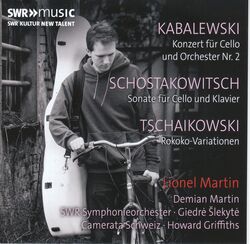Kabalevskys zweites Cellokonzert (1964) ist ein Werk mit viel dunkleren Farben als das erste Konzert. Es wird auch weniger oft gespielt. Dennoch ist es ein sehr schönes, tiefgründiges und geheimnisvolles Werk, das auf diesem Album beispielhaft interpretiert wird.
Der junge Cellist Lionel Martin (*2003) und die litauische Dirigentin Giedre Slekyte (*1989) scheinen sich einig zu sein, überall ein perfektes Gleichgewicht zu halten. Das Tempo bleibt geschmeidig, aber fest, und die Details werden weder geopfert noch übertrieben.
Danach spielen Lionel Martin und sein Bruder Demian Shostakovichs Cellosonate op. 40. Der Cellist spielt das Werk leidenschaftlich-virtuos in den schnellen Teilen, und mit großer expressiver Wärme in den lyrischen Passagen. Er erreicht auch die geistige Dimension, die dem Werk seinen Rang gibt. Es gibt in dieser Interpretation so viel Verinnerlichung, dass man musikalisch vollends gepackt wird, dies nicht zuletzt auch durch das spannungsvolle Spiel von Demian Martin.
Howard Griffiths beginnt die Rokokovariationen sehr bedächtig und bietet dem Solisten die Gelegenheit zu einem sehr kantablen und einfühlsamen Spiel. Doch es gibt ja auch viel Virtuoses und Verspieltes in diesem Stück, und diese schnell wechselnden Stimmungen werden von Martin und dem Orchester überzeugend dargestellt. Martin überzeugt durchgängig mit fesselnder Musikalität, guter Intonation, schönem Legato und insgesamt exzellenter Technik.
Kabalevsky’s second cello concerto (1964) is a work with much darker colors than the first. It is also played less often. Nevertheless, it is a very beautiful, profound and mysterious work, which is exemplarily interpreted on this album. The young cellist Lionel Martin (*2003) and the Lithuanian conductor Giedre Slekyte (*1989) seem united in maintaining a perfect balance throughout. The tempo remains smooth but firm, and details are neither sacrificed nor exaggerated.
Lionel Martin and his brother Demian then play Shostakovich’s Cello Sonata op. 40. The cellist plays the work with passionate virtuosity in the fast parts and with great expressive warmth in the lyrical passages. He also achieves the spiritual dimension that gives the work its status. There is so much internalization in this interpretation that one is completely gripped musically, not least thanks to Demian Martin’s exciting playing.
Howard Griffiths begins the Rococo Variations very deliberately, giving the soloist the opportunity to play in a very cantabile and sensitive manner. But there is also a lot of virtuosity and playfulness in this piece, and the rapidly changing moods are convincingly rendered by Martin and the orchestra. Martin convinces throughout with captivating musicality, good intonation, beautiful legato and overall excellent technique.




















